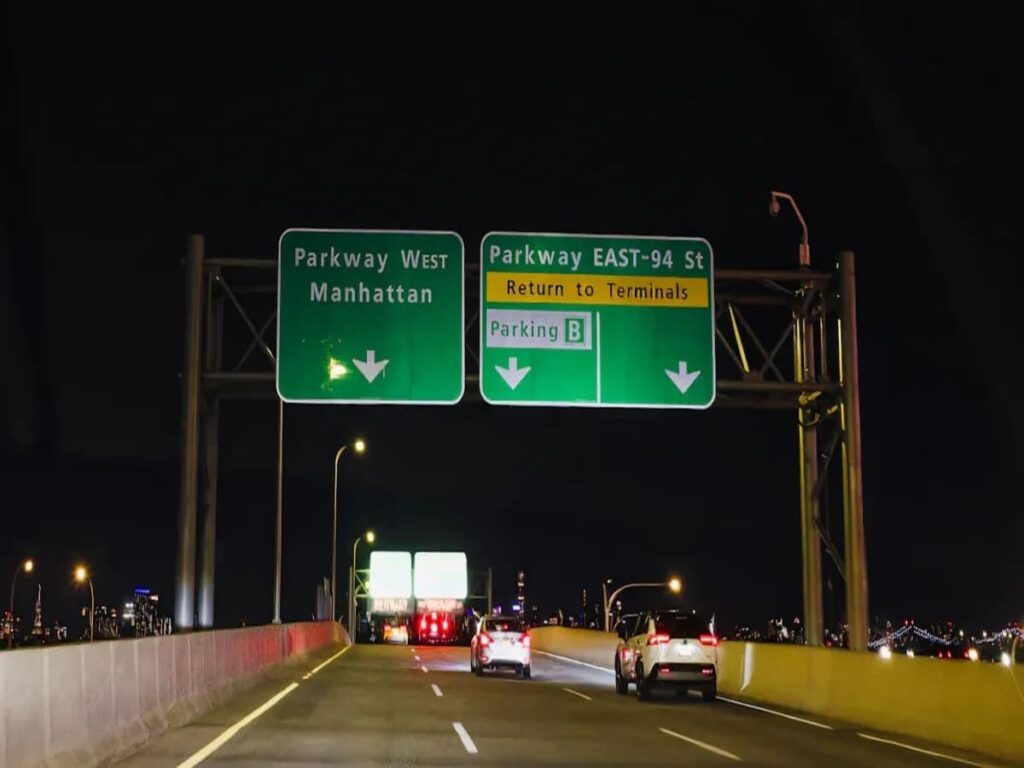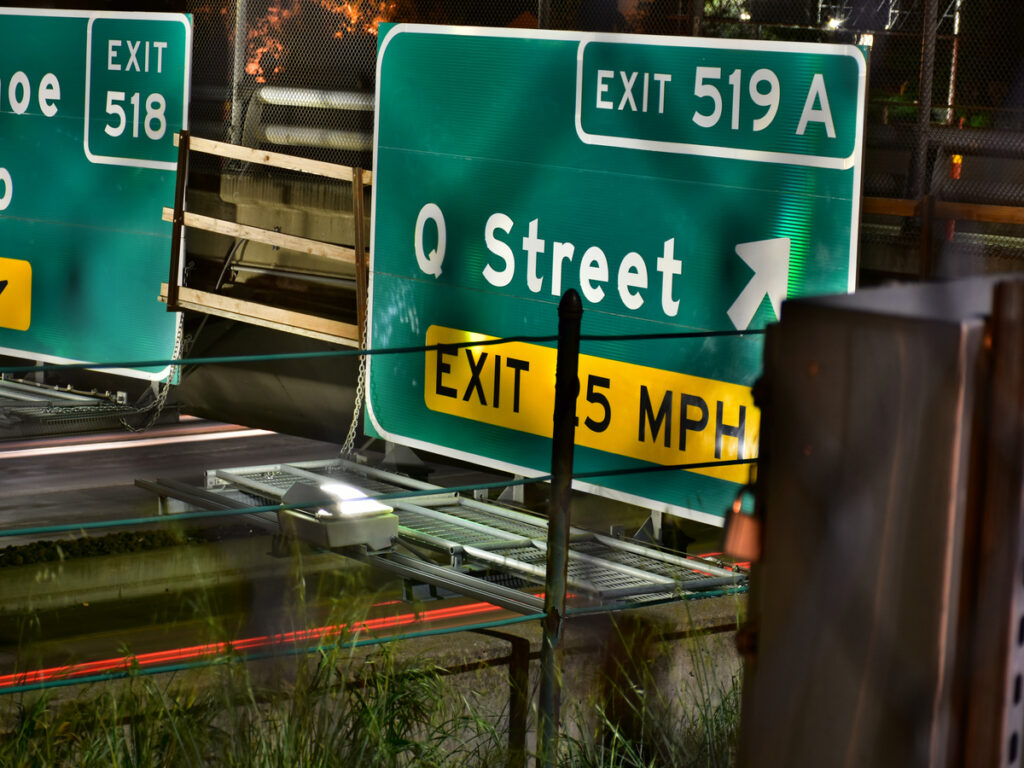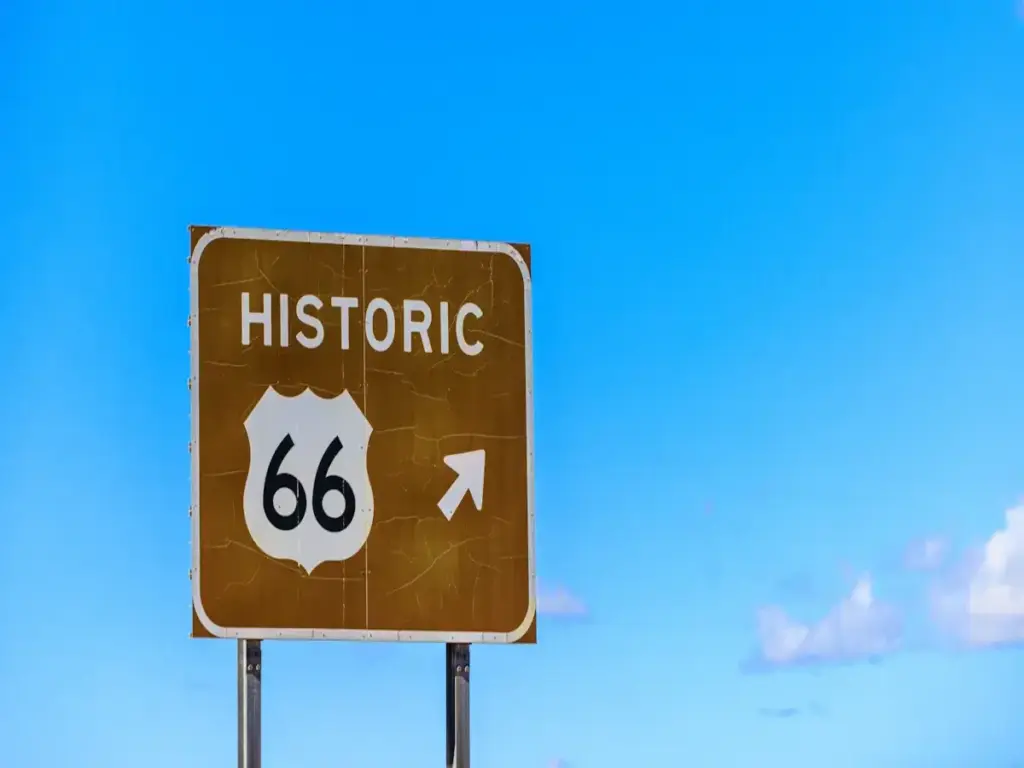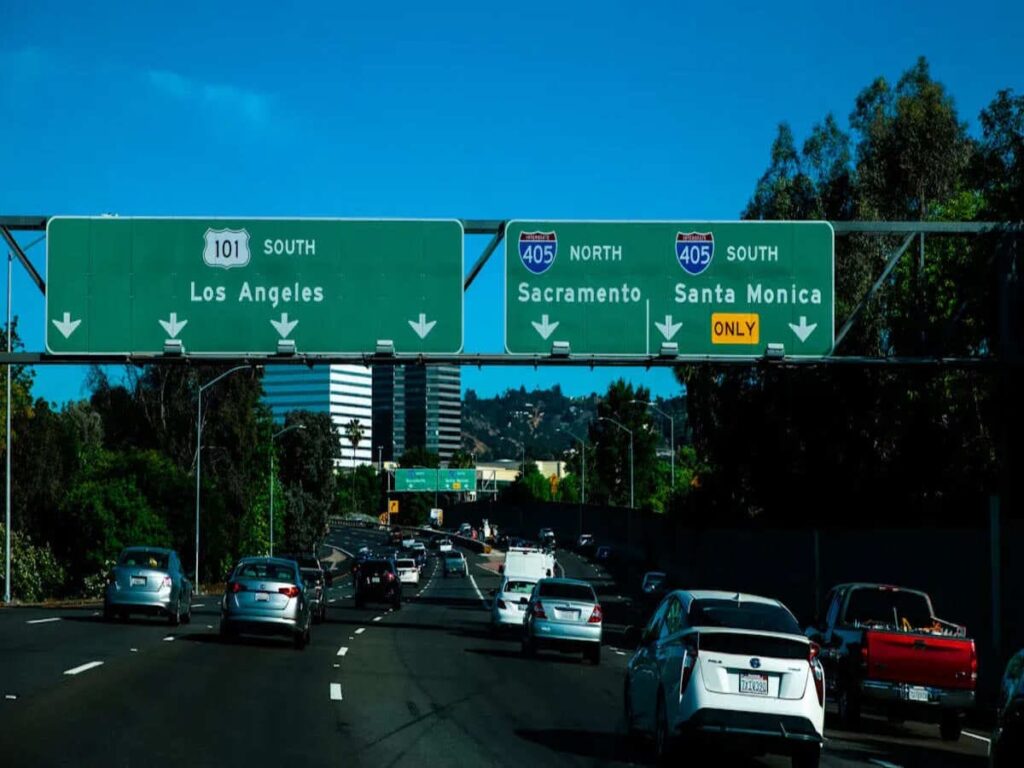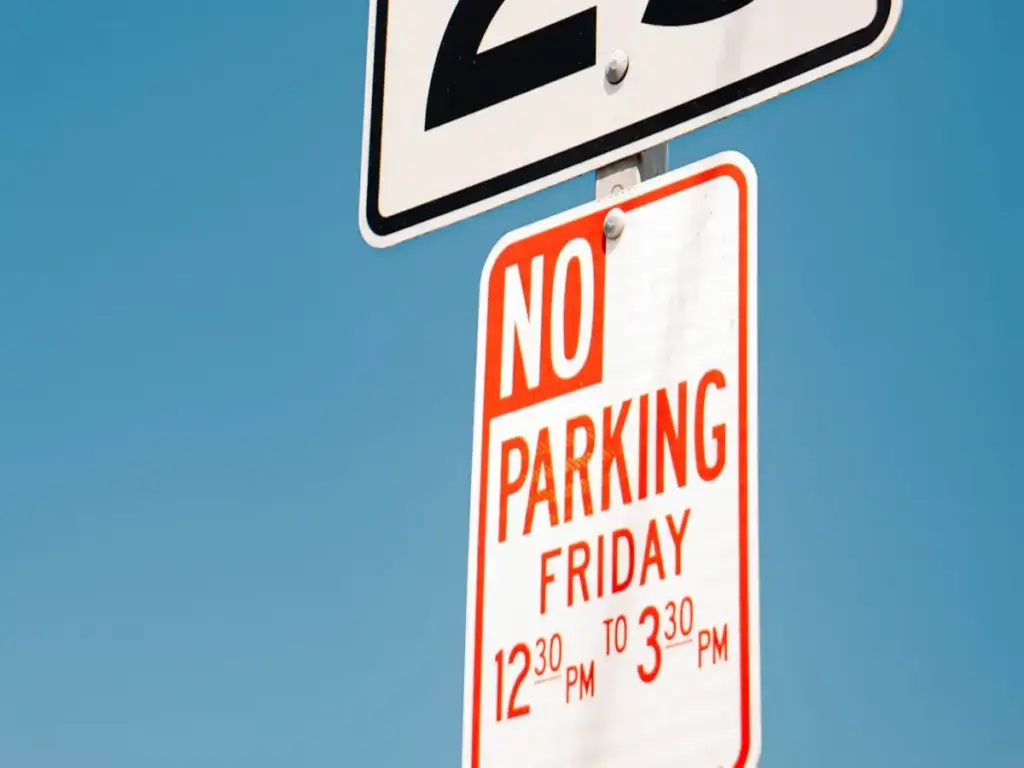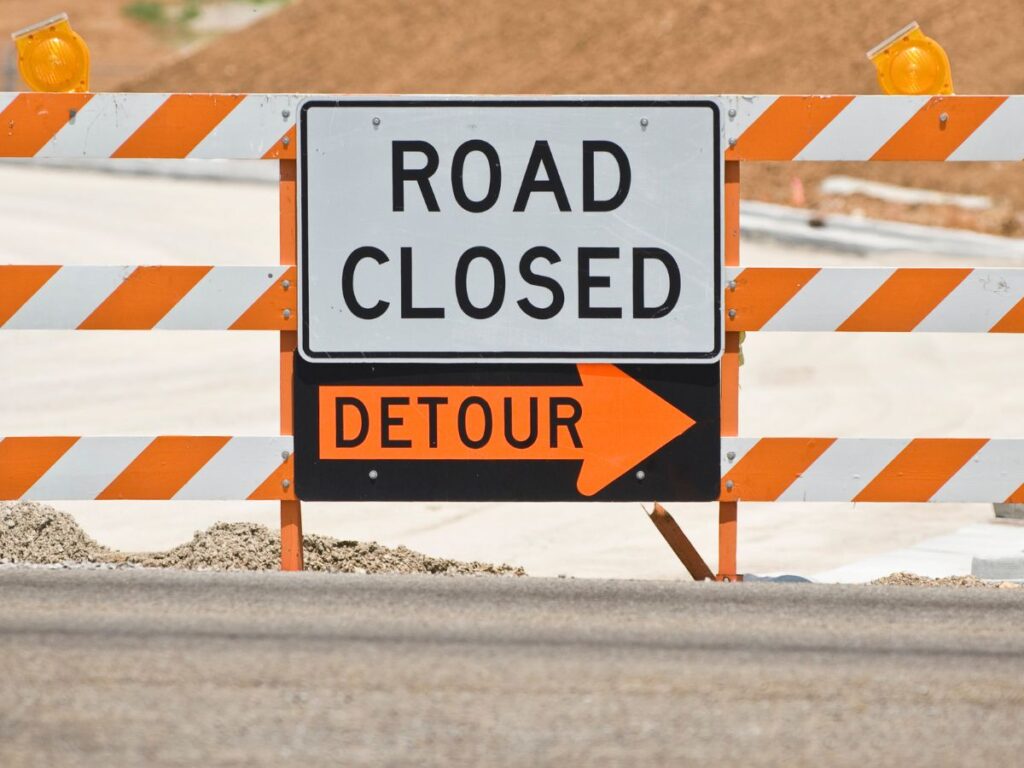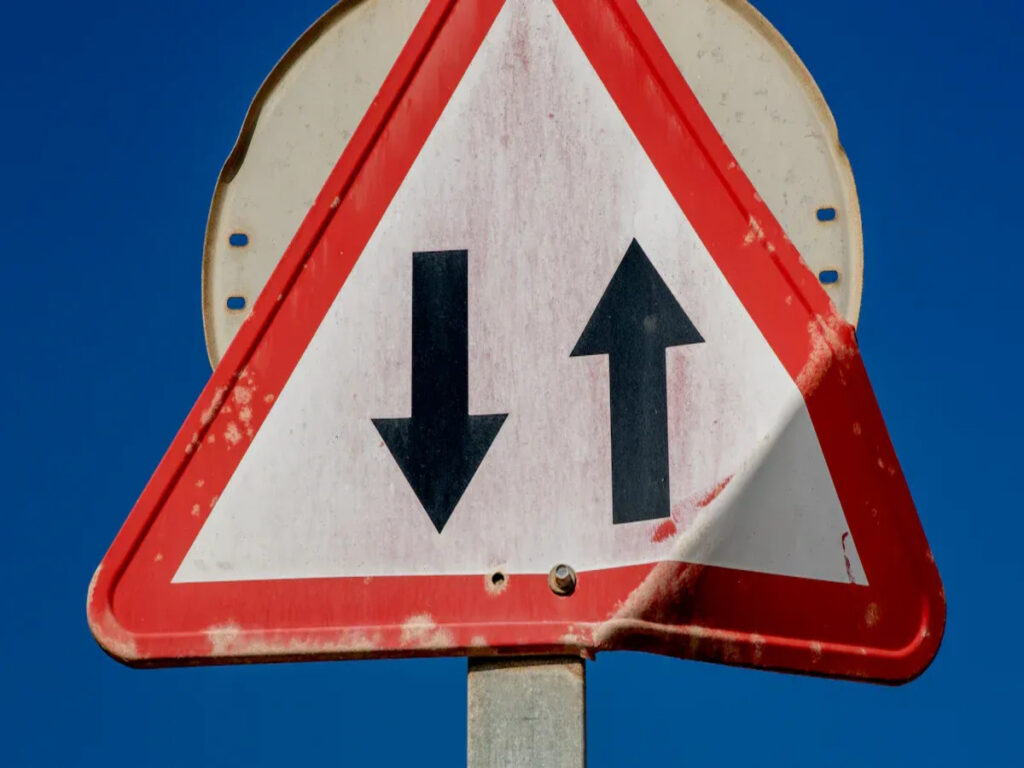
Quando você dirige, você precisa de sinais claros para se manter seguro. O tamanho do sinal da estrada e até onde você pode vê -los importantes. Sinais maiores e mais brilhantes ajudam você a notar -os mais rápido. Sinais com alta retrorreflectividade são mais fáceis de ver. Isso ajuda você a identificar sinais mais cedo e dirigir melhor. Fontes claras em sinais também ajudam você a lê -las rapidamente. Pesquisas mostram que você pode ver sinais 16% mais longe com bons tipos de letra. Existe uma regra simples a seguir. Para todo 100 medidores que você olha, O texto deve ser pelo menos 100 milímetros de altura. Se você conhece esses básicos, você ajuda a manter as estradas seguras para todos.
Na OPTRAFFIC, Seguimos esses princípios ao projetar e fabricar nossos sinais de trânsito. De materiais refletivos de alto grau a tamanhos de fontes e layouts compatíveis, todo Sinal de segurança no trânsito é construído para atender aos padrões de visibilidade e apoiar a direção mais segura em todos os tipos de estrada.
Takeaways -chave
- Sinais de estrada maiores e mais brilhantes ajudam os motoristas a ver mensagens mais rápidas. Isso dá aos motoristas mais tempo para reagir e permanecer seguro.
- Use esta regra: cartas devem ser 1 milímetro de altura para cada medidor que você precisa ver. Isso ajuda as pessoas a ler sinais claramente.
- Escolha fontes e cores claras que se destacam. Isso facilita a leitura de sinais em todo o tempo, mesmo à noite.
- Coloque sinais onde os motoristas podem vê -los bem. Não bloqueie os sinais. Use materiais ou luzes reflexivas para ajudar as pessoas a ver sinais melhor.
- Faça o tamanho do sinal e a altura da letra correspondem à velocidade e área da estrada. Use sinais maiores em estradas rápidas e em lugares arriscados.
Tamanho do sinal da estrada e segurança rodoviária
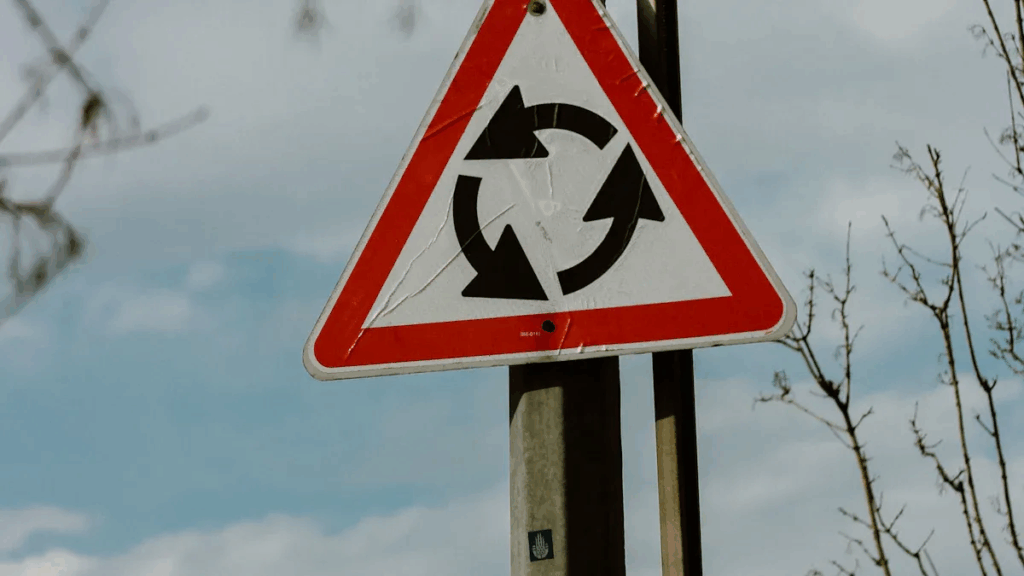
Tempo de reação do motorista
Você precisa reagir rapidamente quando vê uma placa na estrada. O tempo que você tem que ler e entender um sinal pode fazer uma grande diferença para sua segurança. Se o tamanho do sinal da estrada for muito pequeno, Você pode perder detalhes importantes. Sinais maiores e mais brilhantes ajudam você a identificá -los mais cedo. Swift antigo. (2009) descobri que sinais maiores e mais brilhantes permitiam obter informações mais rapidamente e com mais precisão. Isso significa que você passa menos tempo olhando para longe da estrada, o que ajuda você a permanecer focado e seguro. Bom tamanho de sinal da estrada oferece tempo suficiente para desacelerar, mudar faixas, ou pare se necessário. Quando você vê sinais claros de segurança, Você pode tomar melhores decisões e evitar movimentos repentinos que possam causar acidentes.
Dica: Sempre procure sinais, especialmente no tráfego ocupado ou rápido. A detecção precoce dá mais tempo para agir e mantém você mais seguro.
Ambientes de alto risco
Alguns lugares na estrada são mais perigosos que outros. Curvas nítidas, cruzamentos ocupados, E as estradas da montanha precisam de atenção extra. Nesses ambientes de alto risco, A segurança rodoviária depende ainda mais de sinais claros e visíveis. Estudos usando simulações de direção mostram que sinais bem projetados, como sinais de mensagem variáveis, Ajude os motoristas desacelerar e trocar de faixa com segurança. O tamanho certo do sinal da estrada e as mensagens claras podem guiá -lo em pontos complicados. Pesquisas também mostram que os motoristas com conscientização de alto risco notam informações críticas de sinais com muito mais frequência do que outros. Isso significa que uma boa sinalização pode ajudar a todos, Não apenas motoristas experientes. Usar o tamanho correto do sinal da estrada nessas áreas oferece a melhor chance de ver e entender o que você precisa fazer. A segurança rodoviária melhora quando você pode confiar que os sinais o avisarão sobre os perigos à frente.
- Escolha sinais maiores para lugares com pouca iluminação ou muitas distrações.
- Verifique se os sinais se destacam com cores brilhantes e fontes claras.
Você ajuda a proteger a si e aos outros quando prestar atenção aos sinais de segurança e segue suas instruções.
Altura mínima de texto e padrões de visibilidade
COMO 1742 Diretrizes
Existem regras para escolher o tamanho do texto do sinal da estrada. O COMO 1742 diretrizes Ajude a facilitar a leitura dos sinais. Essas regras se concentram em quão bem você pode ver e ler sinais. Eles nem sempre dizem uma altura mínima de texto para cada sinal. Em vez de, Eles mostram como combinar o tamanho da placa na estrada. Você deve pensar em quão rápido os carros vão e quão longe os motoristas estão. As diretrizes dizem que você deve usar uma certa altura da letra para cada metro de distância de visualização. Por exemplo, usar 1 milímetro de altura da letra para cada metro que você deseja que o sinal seja visto. Então, Se você deseja que um sinal seja lido 100 metros de distância, as cartas devem ser pelo menos 100 milímetros de altura. Esta regra ajuda a fazer sinais que os motoristas podem ver e ler a tempo.
Você pode usar matemática para descobrir o melhor tamanho de letra para o seu signo. Essas fórmulas de matemática usam a distância de visualização e quão rápido os carros estão indo. Aqui está uma tabela que mostra como encontrar a altura mínima do texto para diferentes casos:
| Parâmetro/conceito | Fórmula/Descrição |
|---|---|
| Tamanho crítico da impressão (logmar) | CriticalPrintSize = VisualAcuity + AcuityReserve |
| Tamanho mínimo do ponto (pt) | MinimpointSize = 0.09 × ViewingDistance × 10^(CriticalPrintSize) |
| Tamanho máximo do ponto (pt) | MaximMpointSize = 5.4 × DisplayWidth |
| Notas | ViewingDistance em CM; DisplayWidth em CM; 1 pt = 1/72 polegada (0.035 cm) |
| A fonte e o tamanho da tela afetam o melhor tamanho de impressão para a velocidade de leitura |
Você também pode usar uma maneira simples com base na velocidade e distância. Por exemplo:
- Se você dirigir em 45 milhas por hora e tenho 3 segundos para ler, A distância de visualização é sobre 198 pés.
- A menor altura da letra deve ser 6 polegadas, mas 20 polegadas é melhor para vê -lo claramente.
- Se você quiser ler um sinal em 60 pés, A menor altura da letra é 3 polegadas, mas 6 polegadas é melhor para leitura clara.
Dessa forma, ajuda você a escolher a altura da letra certa para cada sinal.
Observação: Sempre verifique o mais recente como 1742 Diretrizes antes de comprar ou colocar novos sinais. Isso garante que seus sinais sigam as regras e sejam fáceis para todos os motoristas ver.
Melhores práticas internacionais
Você pode ver as regras de outros países para ver como eles definem o tamanho do texto do sinal da estrada. O Manual sobre Dispositivos Uniformes de Controle de Tráfego (MUTCD) Nos Estados Unidos, usa uma regra simples para a altura mínima do texto. Você precisa 1 polegada de altura da letra para cada 10 pés de distância de visualização. É como a regra usada na Austrália e em outros lugares. Aqui está uma tabela que mostra como a altura mínima da letra muda com a distância:
| Altura mínima da letra | Distância de visualização máxima |
|---|---|
| 4 polegadas | 100 pés |
| 10 polegadas | 250 pés |
| 16 polegadas | 360 pés |
| 22 polegadas | 500 pés |
| 33 polegadas | 750 pés |
| 43 polegadas | 1000 pés |
| 57 polegadas | 1320 pés (1/4 milha) |
Você pode ver que, à medida que a distância de visualização aumenta, A altura da letra também deve ficar maior. Isso ajuda os motoristas a ter tempo suficiente para ler e reagir. A altura por metro de visualização regra de distância é usada em muitos países. Ajuda você a fazer sinais que funcionam bem em diferentes lugares e em diferentes estradas.
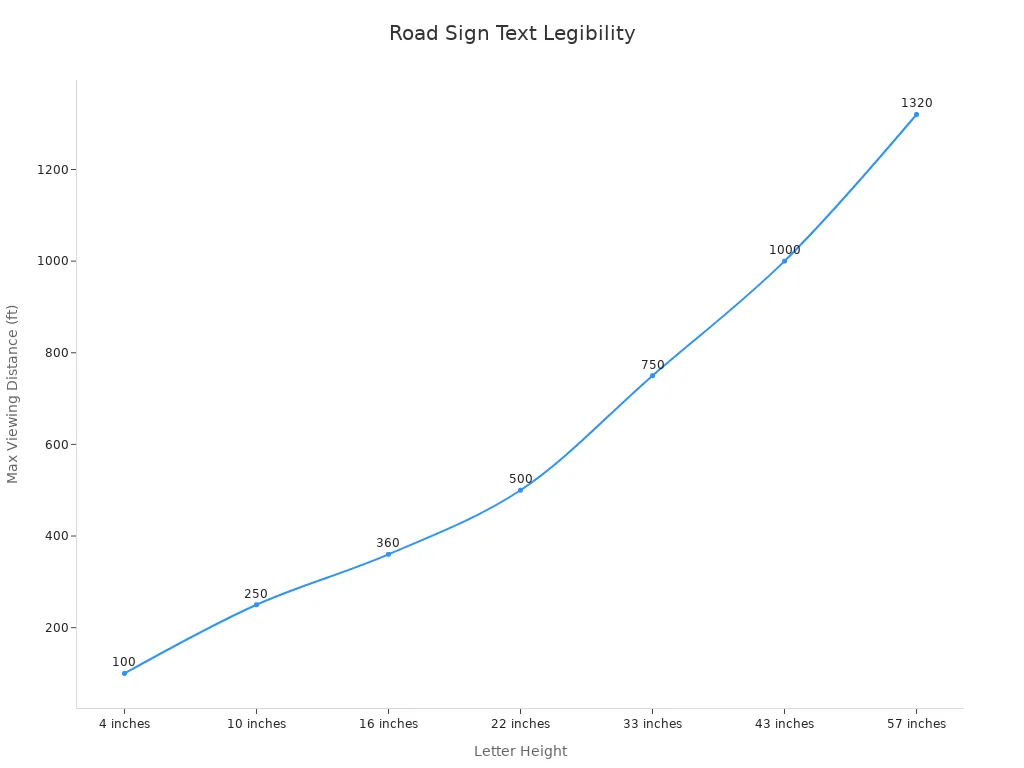
Você sempre deve usar bons sinais que seguem regras locais e internacionais. Isso dá a todos a melhor chance de ver e entender os sinais na estrada.
Distância visual e tamanho do sinal da estrada
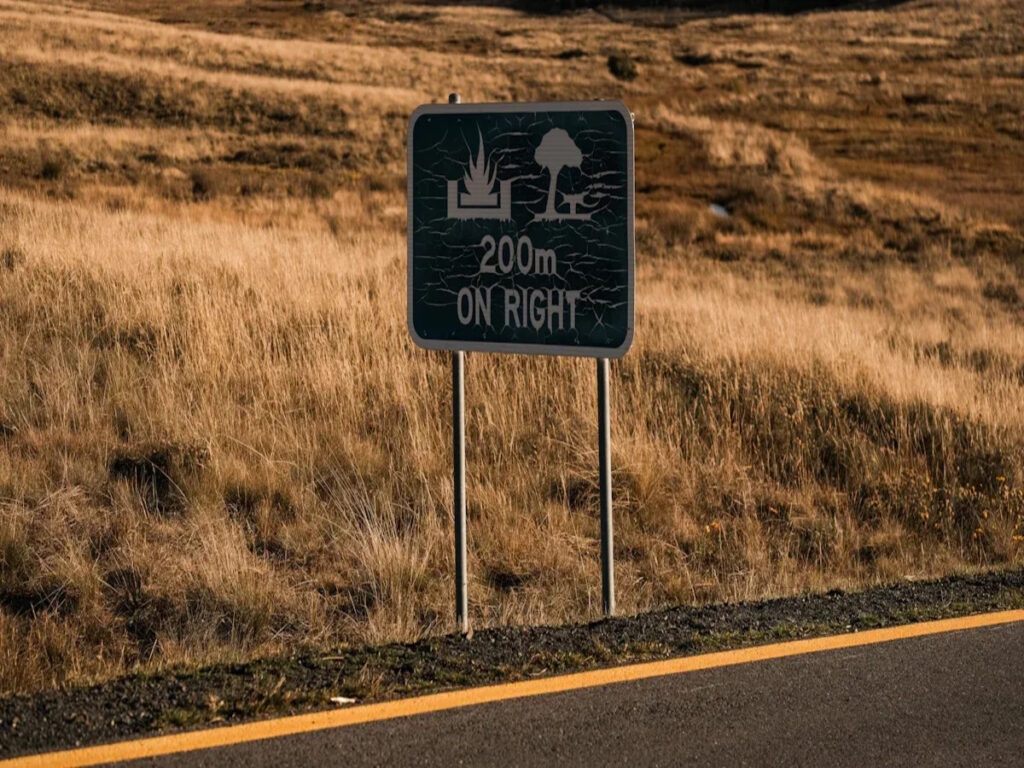
Regras de dimensionamento
Você deve escolher o tamanho certo de sinal para quão longe os motoristas estão. Isso garante que os sinais sejam fáceis de ler. Existe uma regra simples para ajudá -lo. Para cada centímetro de altura da letra, Os motoristas podem ler sobre 10 pés de distância. Se você deseja que um sinal seja lido 100 pés, Use letras que são 10 polegadas de altura. Esta regra funciona para a maioria dos sinais ao ar livre.
Aqui está uma tabela que mostra como as letras maiores ajudam você a ver sinais de mais longe:
| Altura da letra (polegadas) | Distância de visualização ideal (pés) | Distância legível máxima (pés) |
|---|---|---|
| 3 | 30 | 100 |
| 4 | 40 | 150 |
| 6 | 60 | 200 |
| 8 | 80 | 350 |
| 9 | 90 | 400 |
| 10 | 100 | 450 |
| 12 | 120 | 525 |
| 15 | 150 | 630 |
| 18 | 180 | 750 |
| 24 | 240 | 1000 |
| 30 | 300 | 1250 |
| 36 | 360 | 1500 |
| 42 | 420 | 1750 |
| 48 | 480 | 2000 |
| 54 | 540 | 2250 |
| 60 | 600 | 2500 |
Quando você torna as letras maiores, As pessoas podem lê -las de mais longe. Isso ajuda a planejar diferentes estradas e velocidades. Se os motoristas precisam ler sinais de longe, Use letras maiores. Esta regra ajuda você a escolher o melhor tamanho de sinal para qualquer estrada.
Dica: Sempre verifique o quão rápido os carros vão e a que distância os motoristas verão o sinal antes de escolher o tamanho. Sinais maiores ajudam os motoristas a reagir rapidamente e manter todos em segurança.
Faixa de legibilidade
Você quer que todos os motoristas leiam sinais facilmente, Não importa a estrada ou clima. Como é fácil ler um sinal de depende do seu tamanho, a fonte, e quão longe está. Se você usar o tamanho certo de sinal, Os motoristas têm tempo suficiente para ver e entender a mensagem.
Aqui estão algumas distâncias usuais para a leitura de sinais de estrada:
| Tipo de sinal / Doença | Distância típica de legível ou detecção (m) | Notas |
|---|---|---|
| Sinais padrão com 170 MM de texto alto | ~ 115 | Distância de leitura em condições típicas |
| Sinais de guia diagramáticos montados no solo | 125 | Distância mediana da primeira aparência antes das trocas de via rodoviária |
| Sinais de aviso (rodovias rurais) | 137 | Distância média da primeira aparência |
| Pare à frente e pare de sinais (dia) | 274 | Distância do primeiro olhar durante o dia |
| Pare à frente e pare de sinais (noite) | 204 | Distância do primeiro olhar durante a noite |
| Área de sinal de duplicação | +150 para +200 | Aumento da distância de detecção de uma linha de base de 600 m |
| Oposição ao efeito dos faróis | -100 | Redução na distância de detecção de 500 a 900 m de linha de base devido aos faróis que se aproximam |
Você pode ver que sinais maiores ou cartas maiores ajudam as pessoas a lê -las de mais longe. Por exemplo, sinais de parada no dia podem ser vistos de muito mais longe do que os sinais normais. Se você fizer um sinal duas vezes maior, Os motoristas podem ver isso 200 medidores adiante. Mas os faróis brilhantes de outros carros podem dificultar os sinais 100 metros.
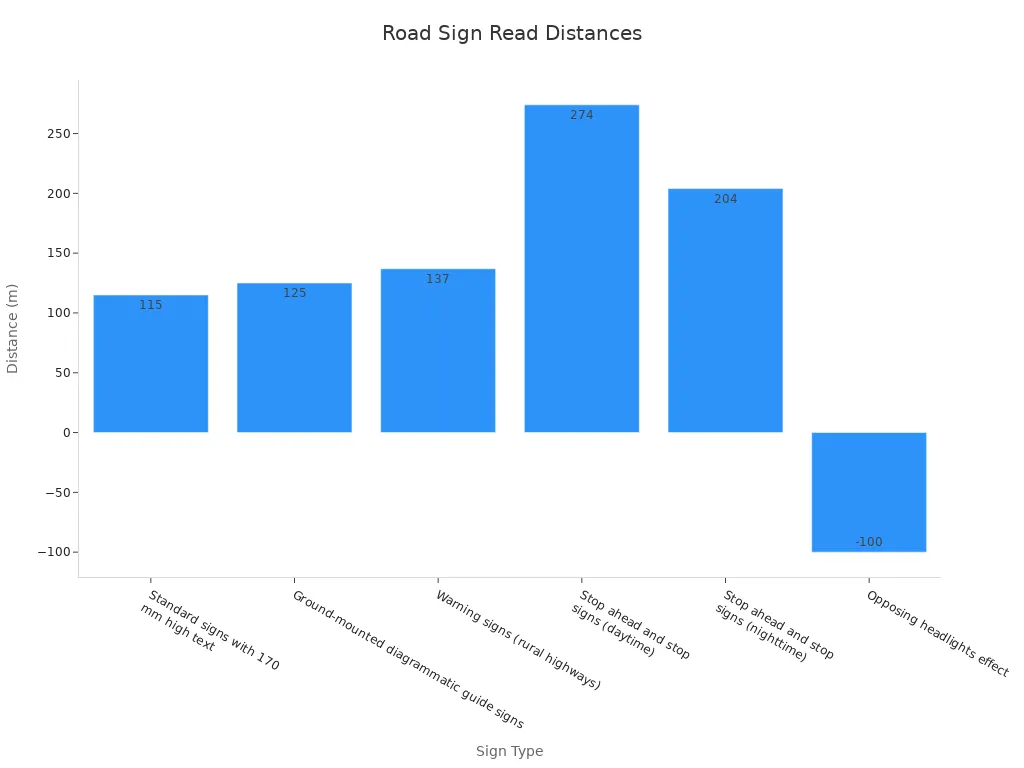
Você deve sempre pensar nos motoristas de distância mais distantes podem ver o sinal. Isso ajuda todos a ler sinais, mesmo com mau tempo ou à noite. Sinais maiores não são apenas mais fáceis de identificar - eles também tornam as estradas mais seguras. Quando você usa o tamanho certo, Os motoristas podem ver sinais mais cedo e fazer escolhas seguras.
Observação: Bons sinais usam o tamanho certo, fontes claras, e são colocados no melhor lugar. Isso dá a todos a melhor chance de ficar seguro na estrada.
Fatores que afetam a segurança dos sinais e a sinalização de qualidade
Fonte e contraste
Escolhendo o direito FONTE DE SINAL E o contraste ajuda a manter as estradas seguras. Fontes fáceis de ler simplificam os sinais. O estilo e o uso de letras maiúsculas mudam a rapidez com que você lê sinais. ClearView Font permite ler sinais de contraste negativo mais rapidamente. Sempre escolha uma fonte que se destaque do fundo. Alto contraste entre letras e fundo facilita a ver sinais. Isso é muito importante no mau tempo ou à noite. Especialistas dizem que você precisa de pelo menos 70% contraste para a melhor visibilidade. Termentos foscos em sinais param o brilho, Então as reflexões não o distraem. Cartas e símbolos devem ter pelo menos 70% O valor da refletância leve contrasta com o fundo. Por aqui, O design da placa da estrada ajuda todos os motoristas a ficarem seguros.
Dica: Use as mesmas cores e fontes claras em sinais. Isso ajuda os motoristas a detectar informações importantes rapidamente.
Colocação e iluminação
Onde você coloca sinais é importante para a segurança. Coloque sinais onde os motoristas podem vê -los sem virar a cabeça muito. Bom design de sinais coloca sinais em grandes pontos de decisão, como curvas ou cruzamentos. Não coloque sinais para trás das árvores ou outras coisas que as bloqueiam. A iluminação muda o quão bem você vê sinais. Os sinais devem ser fáceis de ver dia e noite. Use luzes ou materiais refletivos para destacar os sinais no escuro. Verifique se os sinais não estão escondidos por carros ou arbustos estacionados.
- Coloque sinais no nível dos olhos para motoristas.
- Use luzes ou superfícies refletivas para sinais em lugares escuros.
- Verifique a colocação de sinal frequentemente para manter os sinais claros e fáceis de ver.
Materiais reflexivos
Materiais reflexivos ajudá -lo a ver sinais de longe, especialmente à noite. O material certo torna os sinais mais brilhantes quando os faróis brilham sobre eles. Escolha materiais que atendam aos padrões mínimos de retroreflectividade. A tabela abaixo mostra como a cor e a refletividade afetam o design e a segurança do sinal:
| Tipo de sinal | Combinação de cores | Retrorreflectividade mínima (CD/LX/M²) | Requisito de taxa de contraste |
|---|---|---|---|
| Sinais de guia aéreo | Branco em verde | Branco ≥ 250, Verde ≥ 25 | N / D |
| Sinais de aviso | Preto em amarelo/laranja | ≥ 50 | N / D |
| STOP SIGNS | Branco em vermelho | Branco ≥ 35, Vermelho ≥ 7 | ≥ 3:1 |
Sempre use materiais que mantenham sinais brilhantes e claros por um longo tempo. Cheques e cuidados regulares ajudam a manter os sinais seguros e úteis para todos na estrada.
Escolhendo sinalização de qualidade para diferentes estradas
Velocidade e tipo de estrada
Você precisa combinar sua sinalização na estrada com a velocidade e tipo de estrada. Em rodovias, Os veículos se movem rapidamente. Os motoristas têm menos tempo para ler sinais de rodovias, Então você deve usar letras maiores e materiais mais brilhantes. Por exemplo, Os sinais de rodovias geralmente usam painéis maiores e chapa reflexiva para ajudar os motoristas a identificá -los à distância. Pesquisas mostram que velocidades mais altas significam que você precisa de sinais maiores para reconhecimento seguro. Se você usar pequenos sinais em estradas rápidas, Os motoristas podem perder informações importantes.
Aqui está um guia simples para escolher o tamanho da placa por tipo de estrada:
| Tipo de estrada | Velocidade típica (km/h) | Altura recomendada da letra (milímetros) | Exemplo de tamanho de sinal (milímetros) |
|---|---|---|---|
| Rua Urbana | 40–60 | 100–120 | 600 x 900 |
| Estrada rural | 80–100 | 150–200 | 900 x 1200 |
| Via expressa/rodovia | 100+ | 200+ | 1200 x 1800 |
Você também deve limitar o número de palavras ou nomes de estradas em cada sinal. Muita informação diminui a leitura e aumenta o risco. Especialistas sugerem mantê -lo para 2 a 7 itens por sinal. Isso ajuda os motoristas a processar a mensagem em 2.5 segundos.
Dica: Coloque sinais de rodovia pelo menos 4 pés acima do solo. Use iluminação voltada para a frente ou materiais refletivos de alto grau para obter a melhor visibilidade à noite.
Ambientes especiais
Alguns lugares precisam de sinalização especial na estrada. Curvas, interseções, e as zonas escolares exigem cuidado extra. Para curvas afiadas, Os sinais da Chevron devem ser maiores e espaçados com base no raio da curva. Estudos mostram que os sinais de chevron bem colocados reduzem acidentes e ajudam os motoristas a diminuir a velocidade com segurança. Em áreas com pouca iluminação, Use materiais refletivos mais brilhantes. Para motoristas mais antigos ou rotas turísticas, Aumente o tamanho dos sinais de rodovias para facilitar a leitura.
Você deve seguir os padrões para estradas públicas, como 1742 ou mutcd. Em estradas particulares ou estacionamentos, você tem mais flexibilidade, Mas o uso de padrões de estrada pública mantém todos em segurança. Sempre verifique se sua sinalização atende às necessidades de seus usuários de estrada e do meio ambiente.
Escolher o tamanho certo do sinal e a altura do texto ajuda a manter as estradas seguras. Quando você segue as regras, Os motoristas podem ver e ler sinais rapidamente. Pesquisas mostram que os sinais das pessoas conhecem e podem identificar facilmente ajudá -las a reagir rapidamente e cometer menos erros. Sinais brilhantes e bem iluminados são mais fáceis de ler, mesmo à noite.
Para saber mais sobre como os tamanhos de assinatura são determinados e por que eles são importantes para visibilidade e conformidade, Leia nosso blog: Padrões de tamanho de sinal de trânsito na Austrália: Um guia completo.
Perguntas frequentes
Qual é a melhor maneira de escolher o tamanho certo de sinal para minha estrada?
Você deve corresponder ao tamanho do sinal ao limite de velocidade e à distância de visualização. Use letras maiores para estradas mais rápidas. Sempre verifique os padrões mais recentes da sua área. Isso ajuda você a manter todo mundo seguro.
Como a iluminação afeta a legibilidade do sinal da estrada à noite?
A iluminação ajuda você a ver sinais claramente depois do anoitecer. Use materiais reflexivos ou adicione luzes aos sinais em áreas mal iluminadas. Uma boa iluminação destaca os sinais e reduz o risco de perder informações importantes.
Por que alguns sinais usam cores e fontes diferentes?
Cores e fontes diferentes ajudam você a identificar e entender os sinais rapidamente. Por exemplo, vermelho significa parar ou perigo. Fontes claras facilitam a leitura. Usar o estilo certo melhora a segurança e ajuda a reagir mais rápido.
Posso usar sinais menores em propriedade privada?
Você pode usar sinais menores em estradas particulares ou estacionamentos. No entanto, O uso de tamanhos padrão melhora a segurança para todos. Os motoristas esperam sinais familiares. Seguir os padrões de estrada pública ajuda as pessoas a entender e seguir as instruções.

